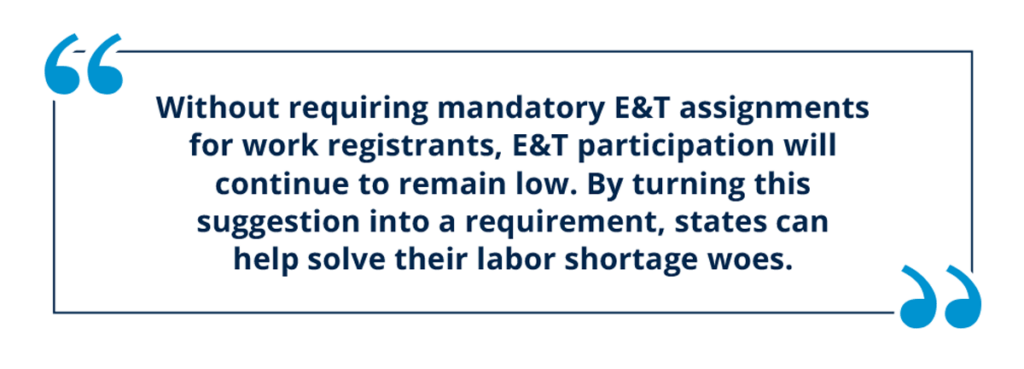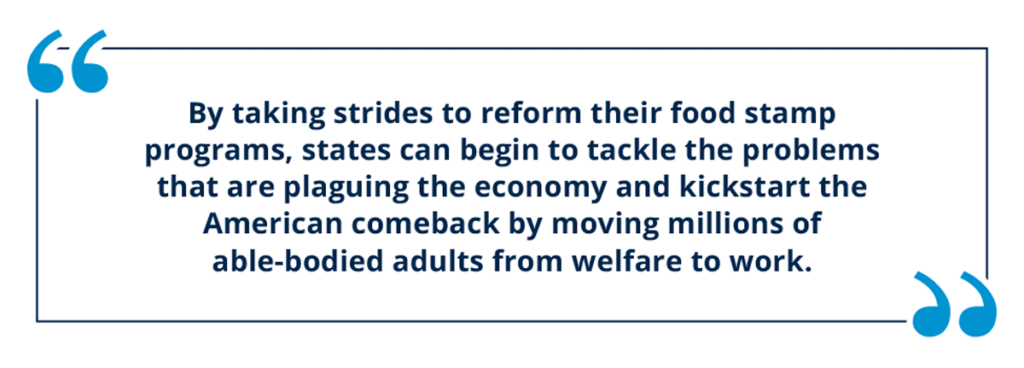Planning for Success: How States Can Reform Their Food Stamp Programs and Revive the Workforce
Key Findings
- Employers are desperate for workers, yet labor force participation remains near a 45-year low.
- Work requirements are a proven way to lift people out of welfare and into self-sufficiency.
- States should require able-bodied adults on food stamps to participate in employment and training (E&T) programs.
- Lawmakers should eliminate the use of loopholes and waivers in food stamps.
Overview
The American economy is facing a massive crisis. Inflation hit a 40-year high, gas prices are skyrocketing, and with two straight quarters of shrinking gross domestic product, the country is teetering on the brink of a recession.1-4
One factor fueling the inflation crisis is the workforce shortage. Currently, there are more than 10.7 million jobs available nationwide—a near-record high—meaning that there are five million more open jobs than people actually looking for work.5-6 Employers are desperate for workers, but labor force participation remains at a near 45-year low.7 Even worse, expanded welfare benefits and the suspension of commonsense work requirements in food stamps have exacerbated the labor force shortage.8
There has never been a better time to get off the sidelines and back to work, yet the economy remains at a standstill. Fortunately, states have simple solutions to help people get back to work and jumpstart an economic comeback.

A blueprint for state lawmakers to revive the workforce
Despite a faltering economy, rising inflation, and record-high fuel prices, states can take steps to reverse course. By moving able-bodied adults from welfare to work, states can reinvigorate their workforces and jumpstart the American comeback.
WORK REQUIREMENTS WORK
Able-bodied adults without dependents (ABAWDs) are people between the ages of 18 and 49 without any dependents in the home.9 Typically, ABAWDs on food stamps must work, train, or volunteer at least part time to qualify for benefits.10 Work requirements in welfare have a long track record of successfully lifting people out of dependency and into self-sufficiency. Studies in multiple states have shown that incomes increased after leaving welfare, people went back to work in diverse industries, and welfare enrollment declined.11-13

For example, in Arkansas, individuals saw their incomes triple within two years of leaving welfare, and incomes more than offset the lost food stamp benefits.14 After reform in Florida, able-bodied adults found jobs in 1,104 different industries, touching nearly every corner of the economy.15 And in Missouri, the number of ABAWDs enrolled in food stamps plummeted by 85 percent after the implementation of work requirements.16 The results are clear: Commonsense work requirements move able-bodied adults from welfare to work, benefiting state economies and increasing incomes along the way.
But this work requirement was “temporarily” suspended due to the COVID-19 pandemic and remains suspended today.17 And the suspension of this powerful tool will continue until the federal government deems that the public health emergency has officially ended.18 Though the federal government has robbed states of this powerful tool until the end of the public health emergency, lawmakers are not without options to reinvigorate their workforces.19
REQUIRE PARTICIPATION IN EMPLOYMENT AND TRAINING PROGRAMS
Nationwide, there are more than 12 million work registrants—able-bodied adults between the ages of 18 and 59 without young children—in the food stamp program.20 The majority of these able-bodied adults do not work at all, and only a small portion even work part time.21 With the suspension of the ABAWD work requirement, the situation has likely only gotten worse.
However, states can require work registrants to participate in employment and training (E&T) programs. E&T programs provide job search training, teach skills relevant to employment, offer career coaching, and much more.22Participants can also work or volunteer to meet program requirements.23
Though state E&T programs are well-funded, few states actually take advantage of this option.24 Unfortunately, 42 states and territories exempt all work registrants from participating in E&T programs.25 Without requiring mandatory E&T assignments for work registrants, E&T participation will continue to remain low.
By turning this suggestion into a requirement, states can help solve their labor shortage woes.

ELIMINATE THE USE OF “NO-GOOD-CAUSE” EXEMPTIONS
Federal law allows states to exempt up to 12 percent of ABAWDs from the work requirement for any reason.26These are known as “no-good-cause” exemptions. Before the pandemic, most states used this loophole—despite the numerous exemptions from the work requirement already available.27
No-good-cause exemptions carry over from year to year with no limit on the accumulation of exemptions.28 For example, if a state does not exempt 12 percent of its ABAWDs in year one, then up to 24 percent of ABAWDs can be exempt from the work requirement in year two.29
Making matters worse, since the ABAWD work requirement is suspended, states have generally not used their no-good-cause exemptions.30 As a result, many states are sitting on a massive stockpile of no-good-cause exemptions. For example, Arkansas, Mississippi, and Texas could exempt every ABAWD on their food stamp program from work requirements for an entire year using their stockpiled exemptions.31

Lawmakers should prevent bureaucrats from using no-good-cause exemptions to maximize the power of the ABAWD work requirement once it is reinstated and begin to fill the millions of open jobs nationwide.
END THE ABUSE OF THE WORK REQUIREMENT WAIVERS
Federal law generally requires ABAWDs on food stamps to work, train, or volunteer part time to remain eligible for benefits.32 Even before the pandemic, states used Clinton-era loopholes to waive work requirements for as many able-bodied adults as possible.33 These waivers were intended to be limited and meant only for areas with unemployment rates above 10 percent or that lacked sufficient job opportunities for able-bodied adults.34

These loopholes allowed states to manipulate old data, game the timeline, and gerrymander areas to waive as many able-bodied adults as possible.35 States also waived work requirements in areas with unemployment rates slightly above the national average—even if the unemployment rate is low.36 In fact, in 2019, two-thirds of able-bodied adults on food stamps had work requirements waived—and as a result, more than one-third of Americans lived in areas with no work requirements at all.37
Bureaucrats are actively preparing for the end of the public health emergency by securing waivers using the same tricks. More than two-thirds of ABAWDs on food stamps live in areas that have already secured waivers, virtually all of them statewide, using data from the height of the pandemic as justification.38
Waiving work requirements deprives individuals of the benefits of moving off welfare and toward work. To get America back to work, lawmakers must crack down on the use of loopholes that allow work requirements to be waived for millions on food stamps.
THE BOTTOM LINE: States should reform their food stamp programs to fast-track the American comeback.
Sky-high inflation, rising gas prices, and more open jobs than people looking for work are a recipe for disaster. Still, there is light at the end of the tunnel for states hoping to reverse course.
By taking strides to reform their food stamp programs, states can begin to tackle the problems that are plaguing the economy and kickstart the American comeback by moving millions of able-bodied adults from welfare to work.

REFERENCES
1. Jonathan Ingram, et al., “Congress must rein in President Biden’s regulatory spending spree to tame inflation,” Foundation for Government Accountability (2022), https://thefga.org/paper/congress-must-rein-spending-to-tame.inflation/.
2. Hayden Dublois and Jonathan Ingram, “How the so-called “Inflation Reduction Act” would actually hurt Americans’ pocketbooks,” Foundation for Government Accountability (2022), https://thefga.org/paper/inflation.reduction-act-would-hurt-americans-pocketbooks/.
3. Derek Saul, “$5 milestone: Gas prices hit an all-time national high,” Forbes (2022), https://www.forbes.com/sites/dereksaul/2022/06/09/5-milestone-gas-prices-hit-an-all-time-national.high/?sh=69a02093654b.
4. Wayne Duggan, “Is the U.S. headed for another recession?,” Forbes (2022), https://www.forbes.com/advisor/investing/is-a-recession-coming/.
5. Bureau of Labor Statistics, “Job openings and labor turnover – June 2022,” U.S. Department of Labor (2022), https://www.bls.gov/news.release/jolts.nr0.htm.
6. Bureau of Labor Statistics, “The employment situation – July 2022,” U.S. Department of Labor (2022), https://www.bls.gov/news.release/pdf/empsit.pdf.
7. Jonathan Bain, “Help wanted: How assigning able-bodied adults to employment and training programs can help solve the labor shortage,” Foundation for Government Accountability (2022), https://thefga.org/paper/employment.and-training-can-solve-the-labor-shortage/.
8. Hayden Dublois and Jonathan Ingram, “The ‘Bidenflation’ crisis: How expanded welfare benefits and labor shortages are driving up prices,” Foundation for Government Accountability (2022), https://thefga.org/paper/bidenflation-crisis/.
9. Food and Nutrition Service, “SNAP work requirements,” U.S. Department of Agriculture (2019), https://www.fns.usda.gov/snap/work-requirements.
10. Ibid.
11. Nic Horton and Jonathan Ingram, “Work requirements are working in Arkansas: How commonsense welfare reform is improving Arkansans’ lives,” Foundation for Government Accountability (2019), https://thefga.org/paper/work-requirements-arkansas/.
12. Nic Horton and Jonathan Ingram, “Commonsense welfare reform has transformed Floridians’ lives,” Foundation for Government Accountability (2019), https://thefga.org/paper/commonsense-welfare-reform-has-transformed.floridians-lives/.
13. Jonathan Bain et al., “Food stamp work requirements worked for Missourians,” Foundation for Government Accountability (2020), https://thefga.org/paper/missouri-food-stamp-work-requirements/.
14. Nic Horton and Jonathan Ingram, “Work requirements are working in Arkansas: How commonsense welfare reform is improving Arkansans’ lives,” Foundation for Government Accountability (2019), https://thefga.org/paper/work-requirements-arkansas/.
15. Nic Horton and Jonathan Ingram, “Commonsense welfare reform has transformed Floridians’ lives,” Foundation for Government Accountability (2019), https://thefga.org/paper/commonsense-welfare-reform-has-transformed.floridians-lives/.
16. Jonathan Bain et al., “Food stamp work requirements worked for Missourians,” Foundation for Government Accountability (2020), https://thefga.org/paper/missouri-food-stamp-work-requirements/.
17. Hayden Dublois and Jonathan Ingram, “How the new era of expanded welfare programs is keeping Americans from working,” Foundation for Government Accountability (2021), https://thefga.org/paper/expanded-welfare.keeping-americans-from-working.
18. Scott Centorino and Alli Fick, “No good cause: How a food stamp loophole could become the next big battle in the war on work,” Foundation for Government Accountability (2022), https://thefga.org/paper/food-stamp-loophole.next-big-battle/.
19. Ibid.
20. Jonathan Bain, “Help wanted: How assigning able-bodied adults to employment and training programs can help solve the labor shortage,” Foundation for Government Accountability (2022), https://thefga.org/paper/employment.and-training-can-solve-the-labor-shortage/.
21. Ibid.
22. Ibid.
23. Ibid.
24.Ibid.
25. Ibid.
26. Scott Centorino and Alli Fick, “No good cause: How a food stamp loophole could become the next big battle in the war on work,” Foundation for Government Accountability (2022), https://thefga.org/paper/food-stamp-loophole.next-big-battle/.
27. Ibid.
28. Ibid.
29. Ibid.
30. Ibid.
31. Ibid.
32. Ibid.
33. Sam Adolphsen et al., “Waivers gone wild: How states are still fostering dependency,” Foundation for Government Accountability (2019), https://thefga.org/paper/work-requirement-waivers-gone-wild/.
34. Ibid.
35.Ibid.
36. Ibid.
37.Ibid.
38. Author’s calculations based upon data provided by the U.S. Department of Agriculture on the number of able-bodied adults without dependents receiving food stamps in fiscal year 2022, disaggregated by state, the jurisdictions waived in the fourth quarter of fiscal year 2022, and the most recent distribution of food stamp enrollees, disaggregated by county.
